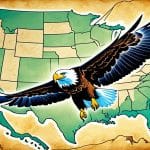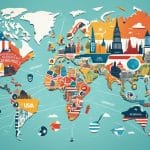Living and Working in The USA
Did you know that over 9 million people from around the world have chosen to make the United States their home? From the bustling streets of New York City to the sun-soaked beaches of California, the USA offers a wealth of opportunities for those seeking a new chapter in their lives.
Whether you’re dreaming of a career in the tech industry, want to explore the country’s natural wonders, or simply yearn for the diverse and vibrant culture, living and working in the USA can be a truly transformative experience. But before you embark on this adventure, it’s crucial to have a comprehensive understanding of what it’s like to live and work in this vast nation.
Key Takeaways:
- In the USA, over 9 million people from around the world have chosen to make it their home.
- The USA offers a wealth of opportunities for career growth, cultural exploration, and immersion in a diverse society.
- Before making the move, it’s important to have a comprehensive understanding of the challenges and opportunities that await you.
- Visa requirements, accommodation options, cost of living, and cultural differences are essential factors to consider.
- Exploring the education system, healthcare facilities, and transportation options will help you settle into your new life.
Visa Requirements for UK Citizens in USA
Before embarking on your journey to the USA, it’s crucial to familiarize yourself with the visa requirements for UK citizens moving to the United States. Understanding the visa options and application process will help ensure a smooth transition to your new life across the pond.
UK citizens have several visa options available to them when relocating to the USA. The most common visas include:
- Visitor Visa (B-2 Visa): If you plan on visiting the USA for leisure, medical treatment, or to visit friends and family, the B-2 Visa is the most suitable option. This visa allows a stay of up to 6 months.
- Student Visa (F-1 Visa): If you intend to study in the USA, you’ll need an F-1 Visa. To be eligible, you must have been accepted into a recognized educational institution in the United States.
- Temporary Work Visa (H-1B Visa): If you have a job offer from a US employer, you may qualify for an H-1B Visa, which is designed for individuals with specialized knowledge or expertise.
- Investor Visa (E-2 Visa): If you plan to invest a substantial amount of money in a US business, the E-2 Visa is an option to consider. This visa requires a significant investment and may lead to permanent residency.
The application process for each visa type varies, but generally, you’ll need to complete the following steps:
- Fill out the appropriate visa application form and submit it online.
- Pay the application fee.
- Attend a visa interview at the nearest US embassy or consulate.
- Provide supporting documents, such as a valid passport, financial statements, employment letters, and educational transcripts.
- Wait for the visa approval or denial notification.
Tips for a Smooth Visa Process:
“Start the visa application process well in advance to allow for any potential delays. Double-check all the required documents and seek guidance from an immigration lawyer if needed.”
Ensuring that you have all the necessary documents and meeting the visa requirements will increase your chances of a successful visa application. It’s important to note that visa requirements can change, so it is advisable to consult the official websites of the US embassy or consulate for the most up-to-date information.
| Visa Type | Key Considerations |
|---|---|
| Visitor Visa (B-2 Visa) | – Intended for leisure, medical treatment, or visiting friends and family – Maximum stay of 6 months |
| Student Visa (F-1 Visa) | – For students pursuing education in the US – Must be accepted into a recognized educational institution |
| Temporary Work Visa (H-1B Visa) | – Suitable for individuals with specialized knowledge or expertise – Requires a job offer from a US employer |
| Investor Visa (E-2 Visa) | – For individuals making a significant investment in a US business – Can lead to permanent residency |
Finding Accommodation in USA
Securing suitable accommodation is essential when moving to the USA. Whether you’re planning a short-term stay or looking for a long-term home, understanding the housing options available will help you make an informed decision. From renting apartments to purchasing properties, there are various choices to consider that cater to different budgets and preferences.
Renting Accommodation
If you prefer flexibility and don’t want the commitment of owning a property, renting is a popular choice. Many cities in the USA offer a diverse range of rental options, from apartments and condos to houses. The rental market is competitive in some areas, so it’s advisable to start your search early and be prepared with the necessary documentation, such as proof of income and references from previous landlords.
Buying a Property
If you’re looking for a more permanent living arrangement, buying a property in the USA can be a worthwhile investment. From cozy suburban homes to luxurious waterfront estates, there is a wide variety of properties available to suit different lifestyles. However, it’s important to research the local real estate market, understand the legalities involved, and work with a reputable real estate agent to guide you through the process.
Shared Accommodation
For those seeking an affordable option or a sense of community, shared accommodation is a popular choice. Sharing a house or apartment with others not only reduces living expenses but also offers opportunities to meet new people and build connections. Websites and online platforms specifically cater to shared accommodation seekers, making it easy to find roommates with similar preferences and interests.
Temporary Accommodation
If you haven’t secured long-term accommodation yet or need a place to stay while you search for the perfect home, temporary accommodation options are available. These include hotels, serviced apartments, and vacation rentals. Temporary accommodation provides flexibility and allows you to explore different neighborhoods before making a final decision.
| Pros | Cons |
|---|---|
| Flexibility | Less stability |
| No maintenance responsibilities | Less control over the property |
| Access to amenities | Potential rent increases |
| No long-term financial commitment | Restrictions on customization |
| Potential for cost savings | No equity gained |
When searching for accommodation, consider factors such as location, proximity to amenities, transportation links, and the overall cost of living in the area. Researching neighborhoods, visiting open houses, and seeking advice from local residents or expat communities can provide valuable insights into the best areas to live based on your preferences and needs.
By familiarizing yourself with the housing options in the USA and taking the time to explore different neighborhoods, you can find a place to call home that meets your requirements and makes your relocation a comfortable and enjoyable experience.
Cost of Living in USA
When considering a move to the USA, it’s important to understand the cost of living to effectively plan your finances. Here, we will explore the various expenses you can expect, providing insights into housing, transportation, healthcare, and groceries.
Housing
One of the largest expenses in the USA is housing. Whether you choose to rent or buy a property, prices can vary significantly depending on the location. Urban areas and popular cities tend to have higher housing costs compared to rural areas. It’s essential to research the housing market extensively and budget accordingly when planning for accommodation in the USA.
Transportation
Getting around in the USA can be convenient but costly. The cost of transportation varies depending on your location and travel preferences. If you live in a city with a well-developed public transportation system, you may be able to rely on buses and trains for your daily commute. However, if you prefer the flexibility of owning a car, expenses such as fuel, insurance, and maintenance should be factored into your budget.
Healthcare
Healthcare costs in the USA can be substantial, particularly for those without insurance coverage. It’s crucial to familiarize yourself with the healthcare system and understand the options available to you. Private health insurance is often necessary to cover medical expenses, and it’s advisable to research different insurance providers to find a plan that suits your needs and budget.
Groceries
The cost of groceries varies across different regions in the USA. It’s advisable to compare prices at different stores and supermarkets to find the best deals. Additionally, if you prefer organic or specialty food items, be prepared for higher prices. Planning your meals and shopping strategically can help you save on grocery expenses.
Understanding the cost of living in the USA is essential for financial planning. By considering housing, transportation, healthcare, and groceries, you can create a realistic budget to ensure a comfortable lifestyle in your new American home.
| Expense | Average Monthly Cost |
|---|---|
| Housing | $1,500 – $3,000 |
| Transportation | $150 – $300 |
| Healthcare | $500 – $1,000 |
| Groceries | $300 – $500 |
Education and Healthcare in USA
If you are considering a move to the USA and have children or require medical services, it is essential to familiarize yourself with the education and healthcare systems in the country. In this section, we will delve into the schooling options available, discuss healthcare insurance, and provide guidance on accessing medical care.
Schooling Options in USA
The United States offers a diverse range of schooling options, ensuring that every child has access to quality education. From public schools to private institutions, parents have the freedom to choose the most suitable educational setting for their children. Public schools are funded by local or state governments and provide education free of charge. Private schools, on the other hand, are independently funded and offer specialized programs or curricula.
Additionally, the USA has prestigious universities and colleges known for their academic excellence and research opportunities. Higher education institutions in the USA attract students from all over the world, offering a wide range of courses and degrees.
Healthcare Insurance in USA
Healthcare in the USA operates primarily through health insurance plans. It is essential to have health insurance coverage to access medical services effectively and manage healthcare expenses. Many employers offer health insurance benefits to their employees, but individuals can also purchase private health insurance plans.
The Affordable Care Act (ACA), often referred to as Obamacare, has made it easier for individuals and families to obtain affordable health insurance coverage. The ACA introduced health insurance marketplaces, where individuals can compare different plans and choose the one that best suits their needs and budget.
Accessing Medical Care
When it comes to accessing medical care in the USA, the country boasts world-class medical facilities and a vast network of healthcare professionals. From primary care physicians to specialists, you will find experienced medical professionals to cater to your healthcare needs.
It is essential to research and identify healthcare providers and facilities in your area. You can ask for recommendations from your employer, colleagues, or local community members. Many healthcare providers have online platforms where you can schedule appointments and access medical records conveniently.
Education and healthcare are vital aspects to consider when relocating to the USA. By understanding the schooling options, healthcare insurance systems, and how to access medical care, you can ensure a smooth transition for you and your family.
Employment Opportunities in USA
The United States of America provides a plethora of employment opportunities for individuals from all walks of life. With its robust and diverse job market, the USA continues to attract professionals from around the world in search of career growth and development. Whether you are a recent graduate, an experienced professional, or an aspiring entrepreneur, the American job market offers a wide range of possibilities for success.
Job Market in USA
The job market in the USA is vast and varied, with opportunities spanning across industries such as technology, finance, healthcare, manufacturing, and more. The country’s strong economy and entrepreneurial spirit contribute to a dynamic job market, often characterized by innovation and competitiveness.
Key sectors driving employment in the USA include:
- Technology and IT: With major tech hubs such as Silicon Valley, Seattle, and Austin, the USA is a hub for tech professionals. The demand for skilled software developers, data analysts, cybersecurity specialists, and artificial intelligence experts is consistently high.
- Finance and Banking: Wall Street in New York City remains a prominent center for finance and banking opportunities, attracting professionals in areas such as investment banking, asset management, and financial analysis.
- Healthcare and Pharmaceuticals: The healthcare sector continues to thrive in the USA, offering a wide range of opportunities for doctors, nurses, medical researchers, pharmacists, and other healthcare professionals.
- Manufacturing and Engineering: The USA maintains a strong manufacturing base, providing employment opportunities for engineers, technicians, and skilled laborers in industries such as automotive, aerospace, and machinery.
- Professional Services: Consulting firms, law firms, marketing agencies, and other professional service providers offer employment opportunities for individuals with specialized skills and expertise.
It is important to note that the job market in the USA is highly competitive. Employers often value relevant experience, advanced qualifications, and specialized skills. Networking and building professional connections can be beneficial when searching for employment opportunities.
Finding Employment or Starting a Business
When looking for employment in the USA, it is advisable to explore various avenues, including:
- Online Job Portals: Websites such as LinkedIn, Indeed, and Glassdoor provide a platform for job seekers to search and apply for positions. Creating a compelling resume and leveraging individual networks can increase the chances of securing employment.
- Networking Events: Attending industry conferences, professional meetups, and career fairs can help expand your professional network and connect with potential employers.
- Company Websites: Many organizations advertise job openings on their official websites. It is recommended to regularly check these websites for relevant opportunities.
- Recruitment Agencies: Working with recruitment agencies specializing in your field can provide access to exclusive job openings and personalized job search assistance.
- Entrepreneurship: The USA is renowned for its entrepreneurial ecosystem. If you have a business idea, exploring the possibility of starting your own venture can be a viable option.
Starting a business in the USA requires careful planning and research. Understanding legal requirements, market demand, and competition is crucial for laying a strong foundation for your enterprise.
Whatever path you choose, it is essential to tailor your applications to the specific requirements of each position, highlighting your relevant skills and experiences. Working on improving your soft skills, such as communication, teamwork, and problem-solving, can also boost your chances of securing employment in the USA.
| Advantages | Challenges |
|---|---|
| Wide range of employment opportunities | High competition for sought-after positions |
| Opportunities for career growth and development | Relocation costs and potential cultural adjustment |
| Access to cutting-edge technologies and innovations | Visa requirements and immigration procedures |
| High earning potential and competitive salaries | Varied work culture and professional expectations |
| Networking opportunities and professional connections | Healthcare and retirement planning |
Taxes and Financial Considerations
When moving to the USA, it’s important to understand the tax system and financial considerations that come with living and working in the country. By familiarizing yourself with the basics of US taxes, you can effectively plan your finances and navigate the tax landscape.
One of the first things to consider is your filing requirements as an expat. In the USA, taxes are levied on both residents and non-residents who receive income from US sources. As an expat, you may still be required to file a tax return, even if you’re not a US citizen or resident.
US taxes can be complex, with various forms, credits, and deductions to consider. It’s crucial to stay informed and seek professional advice to ensure compliance and optimize your tax situation. Deductions such as mortgage interest, education expenses, and retirement contributions can potentially reduce your tax liability.
“Understanding the tax system and knowing your filing requirements is crucial to avoid any penalties or legal issues.”
When it comes to banking and financial services, the USA offers a robust and diverse range of options. From traditional banks to online banking services, you can find a solution that meets your needs. It’s important to research and compare different banks and their offerings to find the best fit for your financial goals and preferences.
Additionally, expats may need to consider currency exchange and transferring funds between different countries. Many banks offer international banking services and foreign currency accounts to facilitate these transactions.
To help you understand the financial aspects of living in the USA, here’s a breakdown of the most common tax forms and their purposes:
| Tax Form | Purpose |
|---|---|
| Form 1040 | Main individual tax return form |
| Form 1040NR | Non-resident individual tax return form |
| Form 1099 | Reporting miscellaneous income received |
| Form W-4 | Employee’s withholding allowance certificate |
Understanding these forms and their purpose can help you navigate the US tax system more efficiently. It’s important to note that tax laws and regulations may change, so staying updated with any updates or amendments is crucial.
In summary, taxes and financial considerations play a significant role in your life when living in the USA. Understanding the tax system, filing requirements, and available deductions can help you plan your finances effectively. Additionally, researching and comparing banking and financial services can ensure your financial needs are met during your time in the country.
Cultural Differences and Social Etiquette
As you settle into your new life in the USA, it’s important to familiarize yourself with the cultural differences and social etiquette that may be different from what you’re accustomed to. Understanding American customs, manners, and social norms will help you navigate your new social environment with ease and avoid any unintentional social blunders.
Cultural Differences
The USA is a diverse country with people from various cultural backgrounds. It’s important to embrace and respect this diversity while also understanding the dominant American culture. Here are some key cultural differences to be aware of:
- The concept of personal space: Americans value their personal space, so it’s important to maintain an appropriate distance during conversations and interactions.
- Direct communication: Americans tend to be direct and to the point in their communication style. They appreciate honesty and expect others to express their thoughts and opinions openly.
- Punctuality: Being on time is highly valued in American culture. It’s considered disrespectful to arrive late for social gatherings, meetings, or appointments.
- Individualism: Americans value individualism and personal freedom. They often prioritize personal goals and achievements over collective interests.
- Tipping: Tipping is customary in the USA, and it is expected to tip in restaurants, hotels, and other service-oriented establishments. The standard tipping rate is around 15-20% of the bill.
Social Etiquette
American social etiquette may differ from what you’re used to. Here are some social etiquette tips to keep in mind:
- Greetings: When meeting someone for the first time, a firm handshake and a smile are common. It’s polite to maintain eye contact during conversations.
- Small talk: Engaging in small talk is a common practice in social settings. Topics like the weather, current events, and sports are safe topics to initiate conversations.
- Dining etiquette: Table manners are important in American culture. Remember to use utensils appropriately, keep your elbows off the table, and wait for everyone to be served before starting to eat.
- Respecting personal boundaries: Avoid asking personal questions or making assumptions about someone’s background, religion, or political beliefs unless they willingly share that information with you.
- Social invitations: It’s common to receive social invitations in the USA. If you receive an invitation, it’s customary to RSVP and arrive on time.
Quote: “Cultural differences are what make our world vibrant and diverse. Embracing and understanding these differences will enrich your experience in the USA.” – Jane Smith
By familiarizing yourself with the cultural differences and social etiquette in the USA, you’ll be better equipped to navigate social situations and foster positive relationships with others. Embrace the opportunity to learn from and connect with people from different cultural backgrounds, and always approach interactions with an open mind and respect for diversity.
| Cultural Differences | Social Etiquette |
|---|---|
| The concept of personal space | Greetings |
| Direct communication | Small talk |
| Punctuality | Dining etiquette |
| Individualism | Respecting personal boundaries |
| Tipping | Social invitations |
Transportation and Infrastructure
Getting around in the USA can be an adventure. From bustling cities to scenic highways, the transportation options are diverse and extensive. Whether you prefer public transportation or driving on your own, there are plenty of choices to suit your travel needs.
Public Transportation
Public transportation systems in the USA vary from city to city. Major cities like New York, Chicago, and San Francisco have comprehensive networks of buses, trains, and subways, making it convenient to navigate urban areas. These systems are well-connected and can take you to key landmarks and attractions within the city.
For example, the iconic New York City Subway system offers a quick and efficient way to explore the city’s boroughs. With numerous lines and stations, it’s easy to access popular destinations such as Times Square, Central Park, and the Statue of Liberty.
Other cities like Los Angeles and Miami have extensive bus networks, allowing you to explore different neighborhoods and suburbs. Additionally, some cities have introduced bike-sharing programs, giving you a fun and eco-friendly way to get around.
Driving Regulations
If you prefer the freedom and flexibility of driving, it’s important to familiarize yourself with the driving regulations in the USA. Each state has its own set of traffic laws and road signs, so it’s crucial to understand the rules specific to your location.
In the USA, driving is on the right-hand side of the road, and speed limits are typically posted in miles per hour (mph). It’s also mandatory to wear seat belts and have valid driver’s licenses and insurance while operating a vehicle.
When driving in urban areas, be mindful of traffic congestion and parking restrictions. Many cities have designated parking areas and parking garages, but it’s important to check for any parking regulations or fees.
Infrastructure
The infrastructure in the USA is well-developed, with a vast network of highways, bridges, and airports connecting different parts of the country. Interstate highways, denoted with an “I” prefix, provide efficient long-distance travel between states.
For example, the famous Route 66 stretches across eight states, offering a scenic journey from Chicago, Illinois, to Santa Monica, California. This historic highway is a popular choice for road trips and showcases the diverse landscapes of the USA.
Air travel is another popular mode of transportation, especially for long-distance journeys. The USA has numerous international and domestic airports, with major hubs in cities like New York, Los Angeles, and Atlanta. These airports offer a wide range of flights to both domestic and international destinations.
Traveling from coast to coast, you’ll experience the sprawling highways, iconic landmarks, and breathtaking views that make the USA a truly remarkable destination.
| Transportation Mode | Advantages | Disadvantages |
|---|---|---|
| Public Transportation | Convenient, cost-effective, reduces traffic congestion | Schedules may vary, limited coverage in some areas |
| Driving | Freedom to explore, flexible travel options | Traffic congestion, parking challenges |
| Air Travel | Fastest mode for long distances, access to remote destinations | Can be expensive, security checkpoints |
Leisure and Recreation in USA
Are you ready to explore the exciting leisure and recreation opportunities that the USA has to offer? From breathtaking national parks to bustling cities, you’ll find something for everyone to enjoy during your time in this diverse country.
Let’s start with the great outdoors. The USA boasts some of the most stunning national parks in the world. Whether you’re a hiking enthusiast or a nature lover, there are plenty of trails and natural wonders to discover. Don’t miss the majestic beauty of Yosemite National Park, the unique rock formations of Bryce Canyon National Park, or the iconic geysers of Yellowstone National Park.
If you prefer city life, the USA has no shortage of vibrant destinations. Explore the bustling streets of New York City, where you can visit iconic landmarks such as Times Square, Central Park, and the Statue of Liberty. Head to Los Angeles for a taste of Hollywood glamour and enjoy the sunny beaches of California. Take a stroll along the charming streets of Charleston, South Carolina, known for its historic architecture and southern hospitality.
Popular Activities and Attractions
When it comes to leisure and recreation, the USA offers a wide range of activities and attractions. Here are some of the must-visit places and experiences:
- Theme parks: Get your adrenaline pumping at Universal Studios in Orlando or Disneyland in California.
- Museums and art galleries: Immerse yourself in art and culture at the Metropolitan Museum of Art in New York City or the Smithsonian Institution in Washington, D.C.
- Sporting events: Catch a baseball game at Fenway Park in Boston or experience the thrill of NFL football at a stadium like Lambeau Field in Green Bay.
- Music festivals: Attend famous music festivals like Coachella in California or Lollapalooza in Chicago.
- Water activities: Enjoy water sports such as surfing in Hawaii, kayaking in the Great Lakes, or swimming in the crystal-clear waters of the Florida Keys.
With such a wide range of activities and attractions, there’s never a dull moment in the USA. Whether you’re seeking adventure in the great outdoors or looking to immerse yourself in cultural experiences, this country has it all.
Events and Festivals
The USA is known for hosting a variety of exciting events and festivals throughout the year. From large-scale celebrations to niche gatherings, there’s something for everyone. Here are a few notable events:
| Event | Location | Date |
|---|---|---|
| Mardi Gras | New Orleans, Louisiana | February or March |
| South by Southwest (SXSW) | Austin, Texas | March |
| Coachella Valley Music and Arts Festival | Indio, California | April |
| Fourth of July Fireworks | New York City, New York | July 4th |
| Albuquerque International Balloon Fiesta | Albuquerque, New Mexico | October |
| Times Square New Year’s Eve Ball Drop | New York City, New York | December 31st |
These events provide unique opportunities to celebrate, be entertained, and experience the vibrant culture of the USA.
As you embark on your leisure and recreation adventures in the USA, make sure to check local guides and resources for up-to-date information on attractions, events, and any safety guidelines.
Weather and Climate in USA
The USA boasts diverse climates and varied weather conditions across its different regions. Understanding the weather patterns can help you prepare for the climate you’ll encounter in your chosen location. Whether you prefer sunny beaches, snowy mountains, or something in between, the USA offers it all.
Let’s explore some of the prominent weather and climate characteristics in different regions of the country.
The West Coast: Sunshine and Mild Temperatures
The West Coast of the USA, including California, Oregon, and Washington, is known for its Mediterranean-like climate characterized by mild winters and warm, dry summers. With plenty of sunshine and relatively low precipitation, this region is ideal for outdoor enthusiasts and nature lovers.
The Midwest: Distinct Seasons
In the Midwest, you can experience the beauty of all four seasons. Summers are typically warm and humid, while winters can be harsh with cold temperatures and heavy snowfall. Autumn brings stunning displays of colorful foliage, while spring brings the rejuvenation of nature.
The Northeast: Four Distinct Seasons with Snowy Winters
The Northeastern states, such as New York, Massachusetts, and Vermont, showcase four distinct seasons. Summers are warm and humid, while winters can be quite chilly with significant snowfall. This region’s snowy landscapes create picturesque scenes, perfect for winter sports enthusiasts.
The South: Warm Winters and Hot Summers
The southern states, including Florida, Texas, and Louisiana, offer a subtropical or tropical climate with mild winters and hot, humid summers. You can enjoy plenty of sunshine throughout the year, making it an attractive destination for those seeking warmth and outdoor activities.
The Rocky Mountains: Varied Climates
The Rocky Mountain region, encompassing states such as Colorado and Montana, is known for its diverse climates. The higher elevations experience colder temperatures and heavier snowfall, making them popular destinations for winter sports. The lower elevations have milder weather conditions, ideal for outdoor adventures and exploring scenic landscapes.
The Southwest: Desert Heat and Dry Climates
The Southwest, including states like Arizona and Nevada, is characterized by desert landscapes and hot, dry climates. Summers can be scorching, with high temperatures exceeding 100°F (38°C). Winters are mild and pleasant, attracting snowbirds who escape the colder regions.
It’s important to note that weather conditions can vary within each region, so it’s advisable to check specific forecasts and local climate data for a more accurate understanding of the weather patterns you can expect.
Next, we’ll delve into the safety and security concerns in the USA, ensuring you have the necessary knowledge to stay safe during your time in the country.
Safety and Security in USA
Safety is of utmost importance when living in any country. When it comes to safety and security in the USA, it’s essential to be aware of crime rates, emergency services, and take precautions to ensure your well-being in various situations.
Crime Rates in the USA
The USA, like any other country, has its own crime rates that vary across different regions and cities. While overall crime rates in the country have decreased in recent years, it is still advisable to stay vigilant and take necessary precautions. Urban areas may have higher crime rates compared to rural areas, so it’s important to research and be aware of the specific safety concerns in the area where you’ll be residing.
Emergency Services
The USA has a well-established emergency service system, offering prompt response for any emergencies. The general emergency number to remember is 911, which can be dialed for immediate assistance in case of accidents, medical emergencies, or any other life-threatening situations. It is crucial to know the proper usage of emergency services and only call 911 in genuine emergencies to avoid overwhelming the system.
Staying Safe in Different Situations
To ensure your safety while living in the USA, it is advisable to follow some basic guidelines:
- Avoid walking alone late at night in unfamiliar or high-crime areas.
- Keep your personal belongings secure, especially in crowded areas like public transport or tourist spots.
- Be cautious with your surroundings and trust your instincts if something feels off or suspicious.
- Research and follow local traffic regulations to ensure road safety while driving or crossing roads.
- Stay informed about any travel advisories or safety alerts issued in the area where you live or plan to visit.
By being aware of your surroundings, staying cautious, and following these safety tips, you can minimize the risks and enjoy a safe experience while living in the USA.
| Emergency Service | Contact Number |
|---|---|
| Police | 911 |
| Ambulance | 911 |
| Fire Department | 911 |
| Poison Control Center | 1-800-222-1222 |
Being aware of the emergency contact numbers is vital in any country, including the USA. Keep these numbers saved on your phone or in a convenient location in case of any emergency.
Social Integration and Expat Communities
Adjusting to a new culture can be challenging, but finding a support network can make the transition smoother. When moving to the USA, social integration and connecting with expat communities can greatly enhance your experience and help you feel at home.
Finding Expat Communities
One of the best ways to connect with fellow expats is by joining expat communities. These communities often organize social events, workshops, and networking opportunities, allowing you to meet people who are going through similar experiences. Here are a few ways to find expat communities in the USA:
- Online platforms: Websites and social media platforms dedicated to expats are a great place to start. Join expat-specific groups, forums, or Facebook communities to connect with others.
- Local meetups: Check for local meetups and gatherings organized specifically for expats. These events provide an excellent opportunity to meet like-minded individuals and build new friendships.
- Community centers: Many cities in the USA have community centers that cater to specific expat communities. These centers often offer language courses, cultural events, and other activities to help you connect with your fellow expats.
By actively engaging with expat communities, you’ll not only meet new friends but also gain valuable insights about living in the USA. Expat communities can provide practical advice, offer support during challenging times, and share valuable information about local resources.
Benefits of Social Integration
Social integration goes beyond simply connecting with fellow expats. It involves immersing yourself in the local culture, making friends with locals, and actively participating in community activities. Here are some key benefits of social integration:
Social integration allows you to build meaningful relationships, broaden your cultural understanding, and truly experience the USA like a local.
- Language proficiency: Engaging with the local community and communicating with native speakers will enhance your language skills and help you become more fluent in English. This can greatly improve your employability and your overall experience in the USA.
- Cultural enrichment: By embracing the local culture, you’ll gain a deeper understanding of American customs, traditions, and values. This cultural enrichment will enrich your life, broaden your perspectives, and foster mutual respect.
- Networking opportunities: Building a diverse network of friends and acquaintances can open doors to new opportunities. Your expat friends can introduce you to their local connections, providing access to job opportunities, recommendations, and insider information.
Overcoming Challenges
While social integration is important, it may come with its own set of challenges. Here are a few tips to help you overcome these obstacles:
- Step out of your comfort zone: Embrace new experiences, try local activities, and be open to meeting new people. It can be daunting at first, but stepping out of your comfort zone will lead to rewarding and meaningful connections.
- Language barriers: If English is not your first language, practice speaking and listening skills regularly. Take language courses or join conversational groups to improve your language proficiency and boost your confidence.
- Active participation: Get involved in community events, join clubs, or volunteer for local initiatives. Engaging in activities that align with your interests and passions will help you connect with like-minded individuals.
Remember, social integration takes time, patience, and effort. Be kind to yourself, embrace the journey, and enjoy the process of building a new life in the USA.
| Benefits of Social Integration | Overcoming Challenges |
|---|---|
|
|
Traveling within USA and Exploring Nearby Destinations
When it comes to travel and exploration, the USA has it all. Whether you’re interested in picturesque landscapes, vibrant cities, historical landmarks, or cultural experiences, there’s something for everyone to enjoy. In this section, we’ll take a closer look at the various transportation options available for traveling within the country, as well as highlight some nearby destinations worth adding to your itinerary during your time in the USA.
Transportation Options
Traveling within the USA is made convenient by a well-developed transportation network. From planes and trains to buses and cars, there are plenty of options to suit different preferences and budgets.
For long-distance travel, domestic flights are a popular choice, allowing you to reach different states quickly and efficiently. Major airlines such as American Airlines, Delta Air Lines, and United Airlines operate flights to various destinations across the country.
If you prefer a more scenic and relaxed journey, train travel is an excellent way to explore the USA. Amtrak offers a comprehensive rail network, with routes that connect major cities and picturesque regions. Sit back, relax, and enjoy the breathtaking views as you traverse the diverse landscapes.
Bus travel is another affordable and flexible option for exploring different parts of the USA. Companies like Greyhound and Megabus provide extensive bus networks, making it easy to travel both short and long distances. Additionally, regional bus companies cater to specific areas, offering convenient transportation options for local exploration.
Of course, if you prefer the freedom and convenience of having your own wheels, renting a car is a popular choice. Renting a car allows you to explore at your own pace, discover hidden gems, and experience the true road trip culture that the USA is known for.
Exploring Nearby Destinations
While there is plenty to see and do within the USA itself, it’s worth considering a trip to nearby destinations during your time in the country. Whether it’s taking a break from bustling cities or immersing yourself in natural wonders, these destinations offer unique experiences that complement your USA adventure.
“The world is a book, and those who do not travel read only one page.” – Saint Augustine
One popular option is a visit to the stunning landscapes of Canada, our friendly neighbor to the north. Explore the vibrant cities of Toronto and Vancouver, or venture into the breathtaking wilderness of Banff National Park and Niagara Falls.
If you’re seeking a tropical getaway, the beautiful islands of the Caribbean are just a short flight away. From relaxing beach retreats to vibrant cultural experiences, the Caribbean offers a taste of paradise within reach.
For those with a penchant for history and culture, a trip to Mexico can be a fascinating addition to your USA exploration. Explore ancient Mayan ruins, discover vibrant city life in Mexico City, or indulge in the delicious cuisine that this diverse country is known for.
Nearby Destinations
| Destination | Highlights |
|---|---|
| Canada | Stunning national parks, vibrant cities, Niagara Falls |
| Caribbean Islands | Beautiful beaches, vibrant culture, water sports |
| Mexico | Ancient ruins, vibrant cities, delicious cuisine |
Exploring nearby destinations offers the opportunity to expand your travel experiences and create lifelong memories. From natural wonders to cultural delights, these destinations add a touch of adventure to your time in the USA.
Whether you choose to immerse yourself in the vastness of the USA or venture beyond its borders, your travel experiences will undoubtedly be filled with unforgettable moments and discoveries. Don’t miss the chance to explore the diverse landscapes, immerse yourself in different cultures, and create memories that will last a lifetime.
Language and Communication in USA
When it comes to language, English is the primary and most widely spoken language in the USA. However, it’s important to note that there are regional variations and slang that you may come across during conversations. Understanding these nuances will help you navigate social interactions and make connections with locals.
While the basic structure and vocabulary of English are consistent throughout the country, there are subtle differences in pronunciation, vocabulary, and grammar. Regional accents, such as the Southern drawl or the New York accent, add rich diversity to the language.
Moreover, American English has its own unique slang and idiomatic expressions. You might hear phrases like “cool beans,” “catch some Z’s,” or “on the fritz.” These colloquialisms may not be immediately recognizable, but don’t worry! The more you immerse yourself in the culture, the more you’ll pick up on these phrases and understand their meanings.
Regional Variations
Across the United States, you’ll find distinct regional variations in vocabulary and pronunciation. Here are a few examples:
- In the South, you might hear “y’all” (a contraction of “you all”) used as a plural form of “you.”
- In the Northeast, the phrase “wicked cool” is used to describe something as incredibly cool or awesome.
- In the Midwest, people often refer to carbonated soft drinks as “pop.”
- In California, you may hear the term “hella” to mean “very” or “a lot.” For example, “That concert was hella good!”
These regional variations add depth to the language and reflect the cultural diversity of the United States. Embracing and understanding these differences can enhance your communication skills and help you connect with people from various backgrounds.
“Language is the road map of a culture. It tells you where its people come from and where they are going.” – Rita Mae Brown
By diving into the language and exploring its regional variations, you’ll not only improve your communication skills, but you’ll also gain insights into the diverse cultures and experiences within the United States.
Communication in a Diverse Society
In the US, communication styles can vary depending on the region and the context. Americans tend to be direct and appreciate concise communication. It’s important to state your point clearly and avoid excessive use of formalities or long-winded explanations.
Non-verbal communication also plays a significant role in daily interactions. Handshakes are a common greeting, and maintaining eye contact during conversations is considered respectful. Additionally, Americans often value personal space and prefer to maintain a certain distance during conversations.
It’s worth noting that communication styles may differ based on factors such as age, profession, and individual personality. In professional settings, for example, communication tends to be more formal and structured, while casual settings may allow for a more relaxed and informal approach.
As you navigate conversations in the USA, remember to listen actively, ask clarifying questions, and be open to different perspectives. Developing effective communication skills will not only help you engage with the local community but also foster meaningful relationships and connections.
Conclusion
In conclusion, living and working in the USA can be an exciting and rewarding experience. Whether you are dreaming of a bustling city life in New York, the sunny beaches of California, or the vibrant culture of New Orleans, the USA offers a multitude of opportunities for personal and professional growth.
Understanding the visa requirements is crucial for a smooth transition. By obtaining the appropriate visa, you can legally live and work in the USA, opening doors to endless possibilities. It is important to research and follow the necessary steps to ensure a successful application.
The cost of living in the USA varies depending on the location, but generally, it is higher than in many other countries. It is important to consider housing, transportation, healthcare, and other expenses when planning your finances. By budgeting wisely and taking advantage of available resources, you can manage your expenses and enjoy the American lifestyle.
The USA offers a diverse job market with numerous employment opportunities. Whether you are looking for a corporate job, starting your own business, or pursuing a career in the arts, there is a place for you. Networking, leveraging professional connections, and staying updated with industry trends can enhance your chances of success.
FAQ
What opportunities and challenges can I expect when living and working in the USA?
Living and working in the USA offers a wealth of opportunities, such as a thriving job market and access to world-class education and healthcare. However, there are also challenges to consider, including the high cost of living and potential cultural adjustments.
What are the visa requirements for UK citizens moving to the USA?
UK citizens planning to move to the USA must obtain the appropriate visa. Options include the H-1B visa for skilled workers, the L-1 visa for intracompany transfers, and the E-2 visa for investors. The visa application process can be complex, so it’s important to seek professional advice and ensure you meet all requirements.
What housing options are available in the USA?
In the USA, you can choose from various housing options, including renting apartments or houses, buying property, or residing in company-provided accommodation. It’s essential to research the local real estate market, consider your budget, and explore different neighborhoods to find the best housing option for you.
What is the cost of living like in the USA?
The cost of living in the USA varies depending on the region and individual lifestyle. Expenses to consider include housing, transportation, healthcare, groceries, and entertainment. It’s advisable to create a budget and factor in these costs to ensure financial stability when living in the USA.
What are the education and healthcare systems like in the USA?
The USA offers a range of school options, including public, private, and international schools. Healthcare in the USA is provided primarily through private insurers, and it’s important to have adequate health insurance coverage. Researching and understanding the education and healthcare systems will help you make informed decisions for yourself and your family.
What employment opportunities are available in the USA?
The USA has a diverse job market with opportunities in various industries. Researching the job market, networking, and connecting with recruiting agencies or online job boards can help you find employment. Alternatively, you may consider starting your own business if you meet the eligibility requirements.
How does the tax system work in the USA?
The US tax system is complex, and it’s crucial to understand your tax obligations and benefits. US residents are required to file an annual tax return, which may involve federal, state, and local taxes. Consider consulting with a tax professional to navigate the intricacies of US taxation and ensure compliance.
What are the cultural differences and social etiquette in the USA?
The USA has a diverse culture with regional variations. Being aware of cultural differences and social norms can help you navigate social interactions effectively. Politeness, punctuality, and respect for personal space are generally valued, but customs may vary. Observing and learning from locals will aid in your social integration.
What are the transportation options like in the USA?
The USA has a well-developed transportation infrastructure, including extensive road networks, public transportation systems in major cities, and domestic flight options. Depending on your location, you may choose to drive, use public transportation, or utilize rideshare services. Familiarize yourself with local transportation options to get around conveniently.
What leisure and recreational activities can I enjoy in the USA?
The USA offers a wide range of leisure and recreational options, from visiting national parks and exploring vibrant cities to attending cultural events and sports games. Each state has its own unique attractions and activities, so take the time to discover local gems and make the most of your time in the USA.
What is the weather like in the USA?
The weather in the USA varies significantly depending on the region. From snowy winters in the Northeast to sunny beaches in the South, each area has its own climate patterns. It’s important to research the weather conditions of your chosen location and prepare accordingly.
How can I ensure my safety and security while living in the USA?
Safety in the USA is a top priority. Familiarize yourself with local emergency services, be aware of your surroundings, and follow common-sense safety precautions. Staying informed about local safety concerns and neighborhoods will contribute to a positive and secure living experience.
How can I integrate and connect with expat communities in the USA?
Adjusting to a new culture can be easier when you have a support network. Seek out expat communities through online forums, social media groups, and local events. Engaging in activities and hobbies that interest you can also help you meet like-minded individuals and foster meaningful connections.
What are the travel options within the USA and nearby destinations?
The USA is vast and offers numerous travel opportunities. Whether you prefer road trips, domestic flights, or train journeys, there are options to explore different regions within the country. Additionally, neighboring countries like Canada and Mexico offer exciting destination possibilities that are just a short trip away.
What should I know about language and communication in the USA?
English is the primary language spoken in the USA, but there may be regional variations and slang. It’s helpful to familiarize yourself with common expressions and dialects in your chosen location. Americans generally value direct communication and may use informal language in certain settings.















